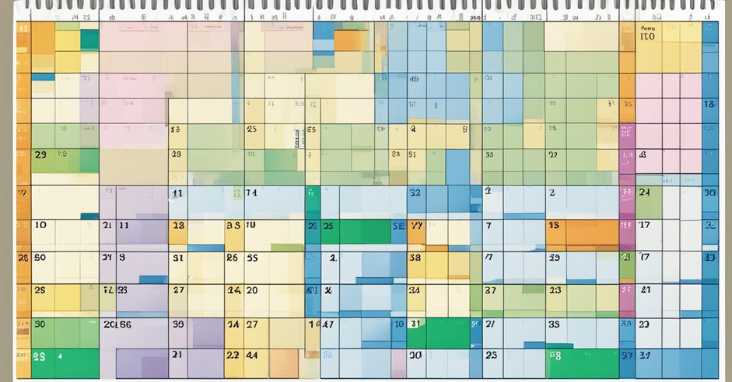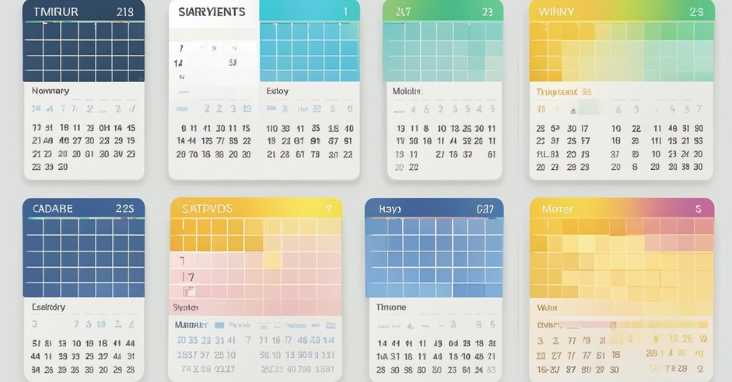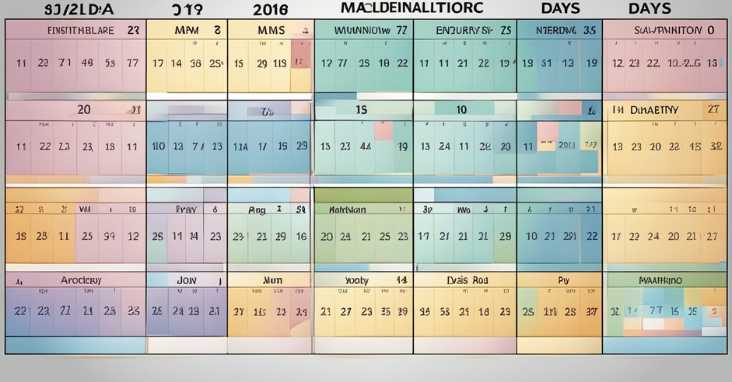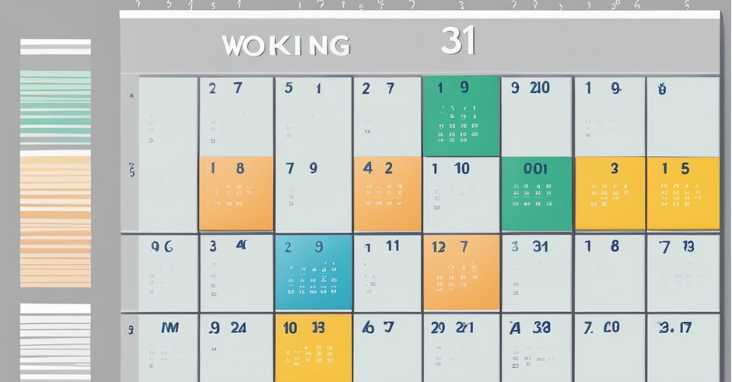How Many Working Days in a Month? Typically, a month has about 20-22 working days, excluding weekends and public holidays. It varies by country and local holidays.
Calculating how many working days in a month is an essential task for businesses, employees, and organizations. It helps to plan schedules, manage workload, and allocate resources efficiently. However, the number of working days in a month can vary depending on several factors, such as weekends, holidays, and work schedules. Therefore, it is crucial to have a clear understanding of how to calculate how many working days in a month and what factors can impact them.

Understanding Working Days
Working days refer to the days when businesses and organizations are open and operate. Typically, working days exclude weekends and public holidays. However, the definition of working days can vary depending on the industry, country, and organization. For instance, some businesses may operate on weekends, while others may have flexible work schedules that include weekends or holidays. Therefore, it is essential to have a clear definition of working days based on the specific context.
Calculating How Many Working Days in a Month
Calculating how many working days in a month requires considering several factors, such as weekends, holidays, and work schedules. One of the simplest ways to calculate working days is to subtract weekends and public holidays from the total number of days in a month. However, this method may not be accurate if the work schedule includes weekends or holidays. Therefore, it is crucial to use practical tools and resources, such as calendars, spreadsheets, or software, to calculate the working days in a month accurately.
Key Takeaways
- Working days refer to the days when businesses and organizations are open and operate.
- Calculating how many working days in a month requires considering several factors, such as weekends, holidays, and work schedules.
- Practical tools and resources, such as calendars, spreadsheets, or software, can help to calculate the working days in a month accurately.
(External resource timeanddate.com)
Understanding Working Days
Definition of Working Days
Working days refer to the days of the week in which most businesses and organizations operate. It is the period of time when employees are expected to be present at work and carry out their designated tasks. Working days are typically from Monday to Friday, but this can vary depending on the industry and the country.
Typical Working Days in a Week
In most countries, the typical working days in a week are from Monday to Friday. This means that there are five working days in a week. However, some countries have different working days, such as a six-day workweek or a four-day workweek. It is important to check the local regulations and customs to determine the typical working days in a particular country.
Weekend Considerations
Weekends are typically considered non-working days, with Saturday and Sunday being the most common days off. However, some businesses and organizations require employees to work on weekends, such as those in the hospitality and healthcare industries. It is important to consider the weekend when calculating how many working days in a month.
To calculate how many working days in a month, it is important to consider the number of weekdays in that month, excluding weekends and any public holidays. This can be done manually or by using a calendar tool or an online calculator.
For more information on working days and how to calculate them, check out this resource from Timeanddate.com.
Calculating How Many Working Days in a Month
Calculating how many working days in a month is a crucial task for businesses and organizations that need to plan their schedules and deadlines. The number of working days in a month can vary depending on weekends, holidays, and other non-working days. In this section, we will explore the general calculation method, working days calculator tools, and adjusting for partial months.
General Calculation Method
The general calculation method for working days in a month is to subtract weekends and holidays from the total number of days in the month. The formula is:
Working days = Total days - Weekends - Holidays
Weekends are usually Saturdays and Sundays, but they can vary depending on the country or region. Holidays can also vary depending on the location and the type of organization.
To calculate the number of weekends in a month, you can use a simple formula:
Weekends = Number of Saturdays + Number of Sundays
To calculate the number of holidays in a month, you can use a calendar or a list of holidays for your location.
Working Days Calculator Tools
There are many online tools and software programs that can help you calculate how many working days in a month. These tools can save time and reduce errors by automatically calculating weekends and holidays for your location.
One example of a working days calculator tool is Timeanddate.com. This website provides a free online calculator that can calculate the number of working days between two dates. The tool takes into account weekends and holidays for your location and provides a detailed report.
Adjusting for Partial Months
Sometimes, you may need to calculate the number of working days for a partial month, such as the first or last week of the month. In this case, you can use a pro-rata calculation method.
The pro-rata calculation method involves calculating the average number of working days per month and multiplying it by the number of days in the partial month. For example, if the average number of working days in a month is 22, and the partial month has 10 days, the calculation would be:
Working days = 22/30 * 10 = 7.33
In this case, the result is a decimal, which can be rounded up or down depending on the organization’s policy.
In conclusion, calculating how many working days in a month is an important task for businesses and organizations. By using the general calculation method, working days calculator tools, and adjusting for partial months, organizations can plan their schedules and deadlines more efficiently.
Impact of Holidays on Working Days
When calculating how many working days in a month, it is important to take into account the impact of holidays. Holidays can significantly reduce the number of working days in a month, which can affect productivity and deadlines.
Public and Federal Holidays
Public and federal holidays are days when most businesses and government offices are closed. These holidays are usually observed nationwide and can vary from country to country. In the United States, for example, federal holidays include New Year’s Day, Martin Luther King Jr. Day, Memorial Day, Independence Day, Labor Day, Columbus Day, Veterans Day, Thanksgiving Day, and Christmas Day. These holidays can reduce the number of working days in a month by up to 10 days per year.
Country-Specific Holiday Variations
In addition to public and federal holidays, many countries have country-specific holidays that can further reduce the number of working days in a month. For example, in India, there are several national holidays such as Republic Day, Independence Day, and Gandhi Jayanti. In China, there are holidays such as Chinese New Year, Tomb Sweeping Day, and Mid-Autumn Festival. These holidays can vary from region to region and can have a significant impact on the number of working days in a month.
Accounting for Christmas and Easter
Christmas and Easter are two major holidays that are observed worldwide. These holidays can have a significant impact on the number of working days in a month, especially in countries with a strong Christian tradition. In many countries, businesses and government offices are closed for several days during the Christmas and Easter holidays. For example, in the United States, many businesses are closed on Christmas Eve, Christmas Day, and the day after Christmas, which can reduce the number of working days in a month by up to three days.
It is important to account for holidays when calculating the number of working days in a month. By doing so, businesses and individuals can better plan their schedules and ensure that deadlines are met. For a comprehensive list of public and federal holidays in the United States, visit USA.gov.
Working Days by Month

January to December Overview
How many working days in a month can vary depending on the month and the year. Generally, a typical month has around 20 to 22 working days, excluding weekends and public holidays. However, this can vary depending on the country and industry.
In the United States, for example, the Bureau of Labor Statistics reports that the average number of working days in a month is 21.7, based on a five-day workweek. However, this can vary depending on the industry and the specific company.
Variations in Month Length
How many working days in a month can also vary depending on the length of the month. February, for example, typically has fewer working days than other months due to its shorter length. In a non-leap year, February has 28 days, which means it typically has around 20 working days.
On the other hand, months with 31 days, such as January, March, May, July, August, October, and December, typically have around 22 working days. Months with 30 days, such as April, June, September, and November, typically have around 21 working days.
Leap Year Adjustments
In a leap year, February has 29 days instead of 28. This means there is an extra working day in February, which typically brings the total number of working days in the month to around 21.
It’s worth noting that the number of working days in a month can vary depending on the country and the specific company. Some countries have different public holidays and weekends, which can affect the total number of working days in a month.
For more information on how many working days in a month, you can check out this resource, which provides a calculator for determining the number of working days in a specific month and year.
Work Schedules and Business Days

Standard Work Week Structure
A standard work week typically consists of five business days, from Monday to Friday. This is the norm for most industries and businesses, although some may operate on different schedules. The number of working hours per day may vary depending on the company’s policy and the employee’s position.
Full-Time vs Part-Time Schedules
Full-time employees usually work for 40 hours per week, while part-time employees work fewer hours. The exact number of hours may vary depending on the company’s policy and the employee’s position. Part-time employees are entitled to fewer benefits compared to full-time employees.
Overtime and Non-Standard Hours
Overtime refers to the hours worked beyond the standard work week. It is usually compensated at a higher rate than regular hours. Non-standard hours refer to the hours worked outside of the standard work week, such as weekends or night shifts. Some companies may offer additional compensation for non-standard hours.
It is important to note that the number of business days in a month may vary depending on holidays and other factors. Employers should provide their employees with a clear work schedule and ensure that they are aware of any changes to it.
For more information on work schedules and business days, check out this resource from the US Department of Labor.
Legal and Business Considerations

Working Time Regulations
Employers must comply with working time regulations that limit the number of hours an employee can work per week. In the United States, the Fair Labor Standards Act (FLSA) sets the standard workweek at 40 hours. However, some states have their own regulations that may differ from the federal law. It is essential for employers to be aware of the regulations in their state to avoid legal issues.
Payroll and Deadline Implications
How many working days in a month can impact payroll and deadline implications. For example, if a company pays its employees on a bi-weekly basis, there may be months where employees receive three paychecks instead of two. This can impact the company’s cash flow and budget. Additionally, deadlines for projects or payments may need to be adjusted to account for the number of working days in a month.
Project Planning and Deadlines
How many working days in a month can also impact project planning and deadlines. It is important for project managers to be aware of how many working days in a month to ensure that deadlines are realistic and achievable. Additionally, unexpected holidays or closures can impact project timelines, so it is essential to have a contingency plan in place.
Employers can use a variety of tools to help them manage how many working days in a month, such as a payroll calendar or project management software. It is also important to stay up-to-date on any changes to working time regulations in order to avoid legal issues.
For more information on working time regulations, please visit the U.S. Department of Labor website.
Practical Tools and Resources

When it comes to calculating how many working days in a month, there are several practical tools and resources available that can make the task easier. Here are some of the most useful ones:
Using Excel for Calculations
Excel is a powerful tool that can help with all sorts of calculations, including determining the number of working days in a month. By using the NETWORKDAYS function, Excel can automatically exclude weekends and holidays from the calculation.
To use this function, simply enter the start date and end date of the period in question, along with any holidays that should be excluded. Excel will then calculate the number of working days between the two dates.
For more information on using Excel for this purpose, check out this helpful guide from Microsoft.
Online Business Days Calculators
There are also a number of online calculators available that can quickly and easily determine the number of business days in a given month. These calculators typically allow you to enter the start and end dates of the period in question, along with any holidays that should be excluded.
One such calculator is the Business Days Calculator, which is available on the Time and Date website. This calculator is easy to use and provides accurate results.
Printable Calendars and Planners
Finally, for those who prefer a more hands-on approach, there are a variety of printable calendars and planners available that can help with calculating working days in a month. These calendars typically include information on weekends and holidays, making it easy to determine the number of business days in a given month.
One such calendar is the Printable 2024 Calendar, which is available on the Calendar Labs website. This calendar includes information on weekends and federal holidays, making it a useful tool for calculating the number of working days in a month.
By using these practical tools and resources, anyone can quickly and easily determine the number of working days in a month. Whether using Excel, online calculators, or printable calendars, these tools can save time and reduce the risk of errors in calculations.
Frequently Asked Questions

What is the method to calculate working days in a month for payroll purposes?
The method to calculate working days in a month for payroll purposes is to count the number of days in the month and subtract weekends and holidays. This calculation can be done manually or with the help of software.
How do you determine the number of working days in a month excluding weekends?
To determine the number of working days in a month excluding weekends, simply subtract the number of weekends in the month from the total number of days in the month.
What is the average number of working days in a typical month?
The average number of working days in a typical month is 22. However, this can vary depending on the industry and the company’s policies.
How do you account for holidays when calculating monthly working days?
When calculating monthly working days, holidays should be subtracted from the total number of days in the month. It’s important to note that some holidays may be observed on different days depending on the company’s policies.
For more information on how to calculate monthly working days, check out this resource.
What is considered a full-time work month in terms of hours and days?
A full-time work month is typically considered to be 160 hours or 20 working days. However, this can vary depending on the company’s policies and the industry.
How can one calculate the total working days in a month for planning and scheduling?
To calculate the total working days in a month for planning and scheduling, simply subtract weekends and holidays from the total number of days in the month. This will give you the number of working days in the month.
For more information on how to calculate working days in a month, check out this resource.















